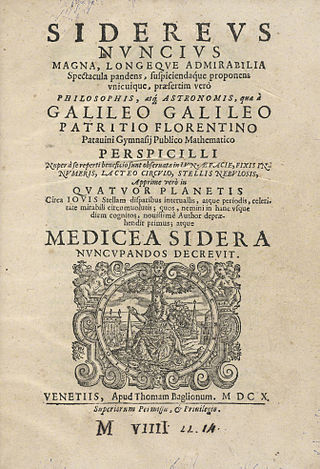
Sidereus Nuncius is a short astronomical treatise published in Neo-Latin by Galileo Galilei on March 13, 1610. It was the first published scientific work based on observations made through a telescope, and it contains the results of Galileo's early observations of the imperfect and mountainous Moon, of hundreds of stars not visible to the naked eye in the Milky Way and in certain constellations, and of the Medicean Stars that appeared to be circling Jupiter.

A refracting telescope is a type of optical telescope that uses a lens as its objective to form an image. The refracting telescope design was originally used in spyglasses and astronomical telescopes but is also used for long-focus camera lenses. Although large refracting telescopes were very popular in the second half of the 19th century, for most research purposes, the refracting telescope has been superseded by the reflecting telescope, which allows larger apertures. A refractor's magnification is calculated by dividing the focal length of the objective lens by that of the eyepiece.
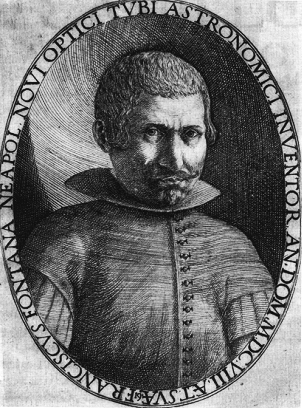
Francesco Fontana was an Italian lawyer and an astronomer.

Museo Galileo is located in Florence, Italy, in Piazza dei Giudici, along the River Arno and close to the Uffizi Gallery. The museum, dedicated to astronomer and scientist Galileo Galilei, is housed in Palazzo Castellani, an 11th-century building which was then known as the Castello d'Altafronte.

Aristodemo Costoli (1803–1871) was an Italian sculptor who spent his entire career in the city of Florence. He is also known for attempting in 1843 to clean and conserve the famed Renaissance-era sculpture David by Michelangelo; unfortunately his hydrochloric acid cleaning solution removed the stone's waxy protective coating and left the surface pitted and porous. His students included Emilio Zocchi, Girolamo Masini, Augusto Rivalta and his son Leopoldo Costoli.

Galileo di Vincenzo Bonaiuti de' Galilei, commonly referred to as Galileo Galilei or simply Galileo, was an Italian astronomer, physicist and engineer, sometimes described as a polymath. He was born in the city of Pisa, then part of the Duchy of Florence. Galileo has been called the father of observational astronomy, modern-era classical physics, the scientific method, and modern science.
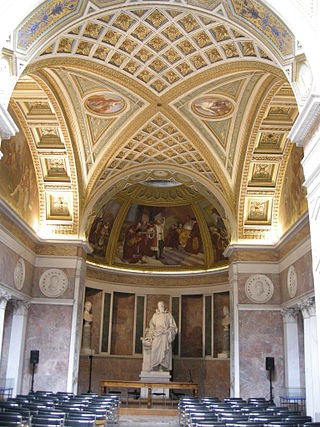
The Tribune of Galileo is a Neoclassic architectural addition, built to commemorate the famous Florentine scientist, Galileo Galilei and to house some of his scientific instruments.

The Old Fortress of Livorno is a castle in Livorno, Italy. The Old Fortress is a successor building to a medieval fort built by the city of Pisa in the location of an older keep built by Countess Matilda of Tuscany in the 11th century. The 11th century tower was incorporated inside the fort built by the Pisans. The castle has been described as a "symbol of Medicean Livorno". The fort is located at the Medicean Darsena, or old dock of the port of Livorno, built by the Medici family. The ceremony proclaiming Livorno a city took place inside the fortress on 19 March 1606.

Vittorio Crosten was an able carver of Dutch origin.

The jovilabe is a brass scientific instrument, undated and of unknown maker, currently in the collection of the Museo Galileo in Florence, Italy.
The Campani compound microscope is a microscope on exhibit at the Museo Galileo in Italy, thought to have been built by optical instrument maker Giuseppe Campani in the second half 17th century. For a time it was thought to have been built by Italian scientist Galileo Galilei but no longer bares that attribution.
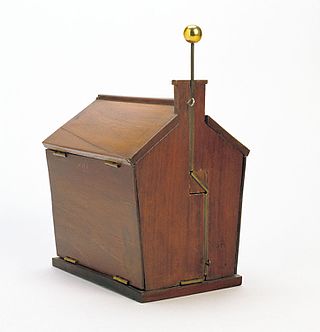
The thunder house is a scientific model invented by James Lind which gives a spectacular demonstration of the destructive effect of a lightning bolt striking a house with an imperfect lightning conductor.
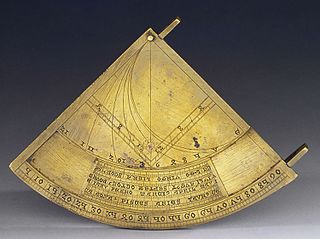
The Quadrans Vetus is a medieval astronomical instrument.

The Instrument of the Primum Mobile is also called the quadrant of Petrus Apianus, because he invented it and described it in the treatise Instrumentum primi mobilis. The instrument is used to find sines and cosines. It bears the initials "F.E.D.P.F." [Frater Egnatius Dantis Predicatorum Fecit]. Ignazio Danti dedicated it to Cosimo I de' Medici, as attested by the Medici coat of arms engraved on the front. The instrument was depicted on the ceiling of the Stanzino delle Matematiche in the Uffizi Gallery.

The Tabula Affinitatum is a table of chemical affinities between substances.

The tall-stem thermometers are a kind of thermometer, resting on branched feet.
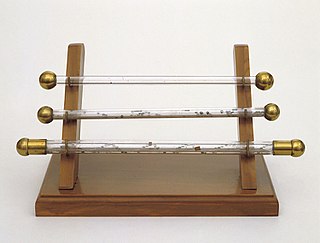
The luminous discharge tube is part of an electric machine.

The elastic and inelastic collisions apparatus is a large apparatus to study elastic and inelastic collisions.

The mechanical paradox is an apparatus for studying physical paradoxes. It consists of a trapezoidal veneered wooden frame with two brass rails, and a pair of brass cones joined at their bases by a wooden disk which rests on the rails. When the double cone is placed at the low end of the frame, it automatically starts to roll upward, giving the impression of escaping the universal law of the gravitational force.

The Reale Museo di Fisica e Storia Naturale was an Italian museum founded on 22 February 1775 in Florence that survived until 1878, when its collections were split up in various Florentine museums.



















